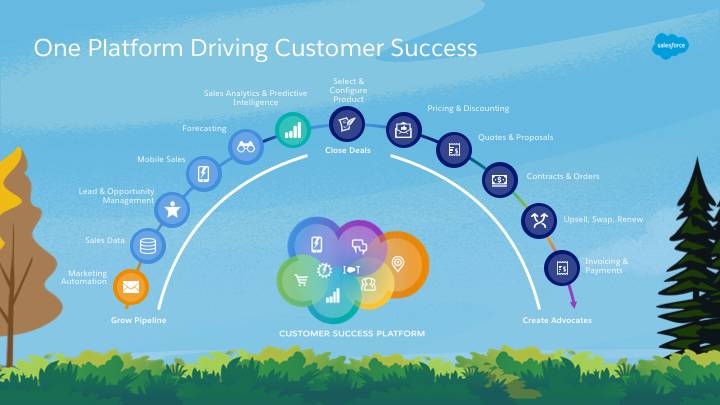Continue Your CPQ Journey
Learning Objectives
After completing this unit, you’ll be able to:
- Explain the importance of CPQ within the greater lead-to-cash cycle.
- Describe how CPQ can benefit teams across your entire business.
- Explain how the role of CPQ has developed over time along with its capabilities.
Note: Be sure you have completed the Salesforce CPQ Basics module before beginning this unit.
Introduction
In our CPQ Basics module, you learned how Salesforce helps your sales team configure products, calculate pricing, and create quotes faster than ever before. Let's continue your CPQ journey by diving into the product and its advanced features.
By completing this module, you’ll learn how CPQ has the power to become the crux of your customer engagements, tying sales to finance and service.

Consider the Lead-to-Cash Lifecycle
Today, it's not just about marketing, or sales, or operations, or service. It's important to think of the entire process and how data is flowing (or not flowing) between activities.
Every customer touchpoint is your chance to show that you value your customers as people. Otherwise, you risk treating them like they're just another transaction. That can give you short-term gain, but in the long run, you miss out on loyalty, building a community of customer evangelists, and recurring business.
Consider this—in an era where people are more connected through smartphones, smart devices, and AI serving up personalized data, 83 percent of B2B buyers expect the companies they do business with to understand them and their needs. In other words, the market is demanding more personal engagements.
This challenge goes well beyond CPQ software and requires you to rethink your processes. But in the following units, you learn how, in the grand scheme of things, CPQ is critical in enabling a deeper customer experience across your business.

Then Versus Now
With the lead-to-cash lifecycle, it’s important to differentiate between a point tool that just helps your sales team generate more quotes and a solution that enables stronger customer relationships overall.
With traditional CPQ, your reps can:
- Pull prices and products.
- Generate quotes.
... and that may be just about it.
What else should a modern CPQ solution do? And how does it plug into the bigger picture, connecting marketing and sales to operations and service?
With Salesforce, quote data resides on the opportunity, providing valuable tracking for campaign performance for marketing and accurate forecasting for sales. Through this market intelligence, your business can better understand what customers want and how you should speak to them.
Salesforce CPQ takes it further—by compiling quote and deal data in one place, it becomes easier to deliver on contracts, which affects how your company recognizes revenue (think making your finance team happy).
Quotes also contain critical info on what services you've sold. So, with this data residing on the Salesforce platform and naturally plugging into Service Cloud, your customer service team has an unfettered view into service level agreements (SLAs). They can see exactly what was sold, how much was sold, and when customers are due for renewals. This empowers them to better prioritize tasks and meet customer expectations (think making your service team happy).
So many happy teams working to make your customers happy!
Resources
State of Sales (signup required)